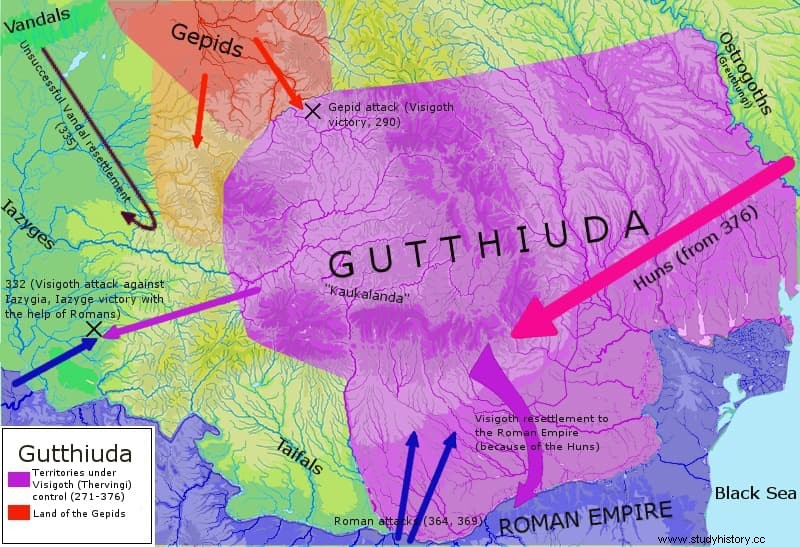The Visigoths were a branch of the Gothic peoples, belonging in turn to the East Germanic tribes that between 600 and 300 B.C. they migrated from Scandinavia to the region between the Oder and Vistula rivers.
Some researchers believe that the Visigoths are the same people as the Thervingi , as the 6th-century AD historian Jordanes says that the kings of him, from Alaric I to Alaric II, were heirs to the Thervingian judge Athanaric. But the issue has been under discussion for a long time.
Herwig Wolfram states that vesi would be the term with which the tribe designated itself, while tervingi It was just a geographic identifier. This would explain why the term tervingios It fell out of use when the Visigoths were displaced by the Hun invasions.

In any case, we know that the Visigoths invaded the Italian peninsula, sacking Rome in 410 AD. They then settled in southern Gaul as foederati (federates) of the Roman Empire, and in 507 A.D., after the defeat against the Franks, they settled definitively in Hispania (partially dominated since 415) where they would create the Visigoth kingdom of Toledo.
The Visigoths came into contact with the Roman Empire, and its language, around the fourth century, possibly before their invasion in 376 and their victory at the Battle of Adrianople in 378. The language they spoke, and which we know as gothic , they called it gutisko razda and was spoken by both the Visigoths and the Ostrogoths.

We know it because, unlike other Germanic languages such as Burgundian or Vandal, of which no written texts have survived, some fragments of Gothic have survived to this day. The oldest of all these texts is the translation of the Bible made from the Greek by the Gothic bishop Ulfilas in the fourth century, which is preserved in the Codex Argenteus o Silver Bible (6th century copy of the original from the 4th), exhibited in the library of the University of Upsala in Sweden.
Both the Silver Bible and other later documents, for example the Skeireins (Gothic word meaning explanation ) from the Codex Ambrosianus of Milan, were written in Gothic using an alphabet whose invention is attributed to Bishop Ulfilas himself, with 25 letters adapted from the Greek alphabet with the addition of runes and Latin characters.
The Gothic language was reduced to the Visigoths of the Iberian Peninsula after the elimination of the Ostrogoths of the Italian Peninsula with the Byzantine conquest, going into decline from the middle of the 6th century. The conversion of the Visigoths to Catholicism in 589 was one of the main factors in their progressive abandonment. But still, it continued to be spoken until the 8th century, probably until the time of the Muslim invasion.

A dialect of Gothic continued to be spoken on the Crimean peninsula until the end of the 18th century. It is mentioned by the monk Walafrido Strabo, who wrote in the first half of the 9th century and was abbot of the Reichenau monastery. And later a letter from the Flemish ambassador to the Ottoman Empire Ogier Ghiselin de Busbecq, dated 1562, includes a list of 80 words and a song in Crimean Gothic .

Gothic is considered the oldest Germanic language for which there is documentary evidence. It became extinct without leaving derived languages and, in the case of the Iberian Peninsula, after the Muslim conquest, the Visigoths that remained were diluted among the mixture of peoples from the different kingdoms that were emerging (also in Al-Andalus) and were replacing their original language by the new Romance languages.
But that the gothic Being an extinct language does not mean that it has disappeared forever. There is even a version of Wikipedia in Gothic, and J.R.R. Tolkien published a poem in that language titled Bagme Bloma (The Flower of the Trees) in the 1936 volume Songs for the Philologists . More recently, in 2015, a gothic translation of Alice in Wonderland appeared. titled Balþos Gadedeis Aþalhaidais in Sildaleikalanda , work of David Carlton.
Anyone interested in learning Gothic has many resources at their disposal online, including the Grammar of the Gothic Language written by Joseph Wright in 1910. And even free lessons on Youtube.

But what did the Gothic sound like? ? Because Ulfilas used the same writing conventions as the Greek of his day, and because the Greek is well documented, it has been possible to largely reconstruct Gothic pronunciation through comparative phonetics, and by looking at how non-Greek names are transcribed in the Silver Bible.
Gothic used a prosodic or sentence stress, that is, depending on the composition of the sentence, instead of the typical Indo-European pitch stress (applied to the syllable of a word). Thus, as a general rule, the stress was fixed on the first syllable of simple words.
In compound words, it depended on whether the second word was a noun, in which case the first syllable of the first word was stressed, or if it was a verb, the first syllable of the verb being stressed.
